欧洲泌尿外科学会勃起功能障碍诊疗指南(2011年版)简介
- 格式:pdf
- 大小:395.93 KB
- 文档页数:5
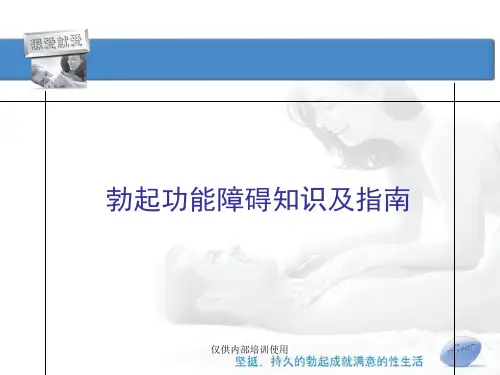

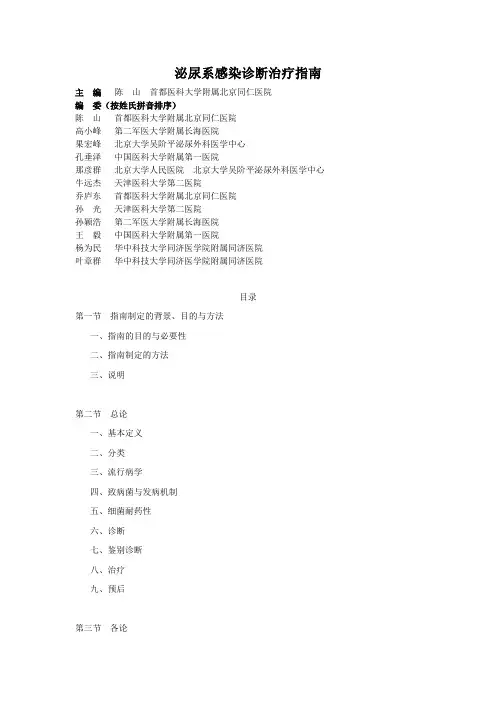
泌尿系感染诊断治疗指南主编陈山首都医科大学附属北京同仁医院编委(按姓氏拼音排序)陈山首都医科大学附属北京同仁医院高小峰第二军医大学附属长海医院果宏峰北京大学吴阶平泌尿外科医学中心孔垂泽中国医科大学附属第一医院那彦群北京大学人民医院北京大学吴阶平泌尿外科医学中心牛远杰天津医科大学第二医院乔庐东首都医科大学附属北京同仁医院孙光天津医科大学第二医院孙颖浩第二军医大学附属长海医院王毅中国医科大学附属第一医院杨为民华中科技大学同济医学院附属同济医院叶章群华中科技大学同济医学院附属同济医院目录第一节指南制定的背景、目的与方法一、指南的目的与必要性二、指南制定的方法三、说明第二节总论一、基本定义二、分类三、流行病学四、致病菌与发病机制五、细菌耐药性六、诊断七、鉴别诊断八、治疗九、预后第三节各论一、单纯性尿路感染二、复杂性尿路感染三、导管相关的尿路感染四、泌尿外科脓毒血症第四节泌尿外科抗菌药物应用相关指南一、特殊情况下的抗菌药物应用二、泌尿外科围手术期抗菌药物应用第五节泌尿系感染的随访、预防和患者教育一、尿路感染的随访二、尿路感染的预防三、尿路感染患者教育附录常用抗菌药物名称中英文对照第一节指南制定的背景、目的与方法一、指南的目的与必要性目前国内泌尿外科医师在泌尿系统感染性疾病及抗菌药物应用方面研究较少,在临床抗菌药物使用方面缺乏明确的指导,同时由于泌尿外科各类导管的普遍使用、内腔镜操作的增加等,使得相关的感染性疾病发生率增加,而在治疗方面却存在诸多的问题,因此有必要制定相关指南以提高泌尿外科医师对泌尿系统感染性疾病的诊疗水平,减缓细菌耐药性的发展并保障患者用药的安全和有效,以期达到中国泌尿外科医师对泌尿系统感染性疾病的诊疗和抗菌药物应用规范化的目的。
二、指南制定的方法由于泌尿系感染几乎涵盖临床各个科室,而且涉及抗菌药物使用问题,所以我们在制定过程中遵循循证医学的原则与方法,检索了国内外大量文献(以近五年的文献为主),经过反复讨论,并与相关学科的专家进行了深入的交流以确保指南的准确性。
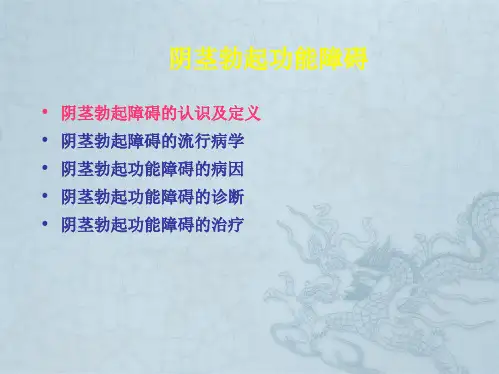
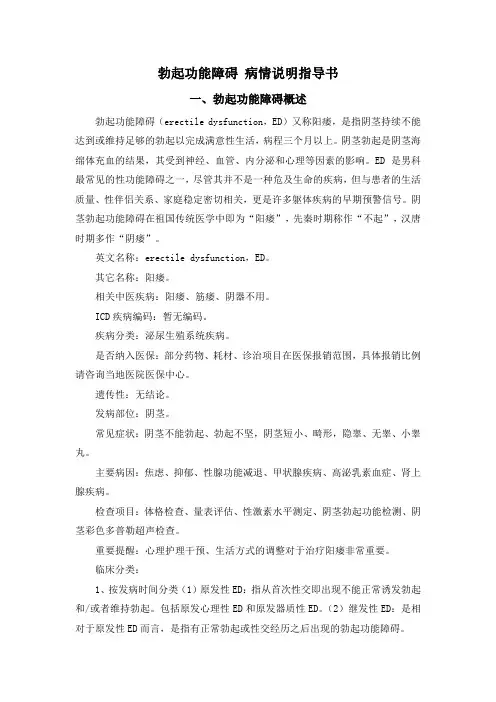
勃起功能障碍病情说明指导书一、勃起功能障碍概述勃起功能障碍(erectile dysfunction,ED)又称阳痿,是指阴茎持续不能达到或维持足够的勃起以完成满意性生活,病程三个月以上。
阴茎勃起是阴茎海绵体充血的结果,其受到神经、血管、内分泌和心理等因素的影响。
ED 是男科最常见的性功能障碍之一,尽管其并不是一种危及生命的疾病,但与患者的生活质量、性伴侣关系、家庭稳定密切相关,更是许多躯体疾病的早期预警信号。
阴茎勃起功能障碍在祖国传统医学中即为“阳痿”,先秦时期称作“不起”,汉唐时期多作“阴痿”。
英文名称:erectile dysfunction,ED。
其它名称:阳痿。
相关中医疾病:阳痿、筋痿、阴器不用。
ICD疾病编码:暂无编码。
疾病分类:泌尿生殖系统疾病。
是否纳入医保:部分药物、耗材、诊治项目在医保报销范围,具体报销比例请咨询当地医院医保中心。
遗传性:无结论。
发病部位:阴茎。
常见症状:阴茎不能勃起、勃起不坚,阴茎短小、畸形,隐睾、无睾、小睾丸。
主要病因:焦虑、抑郁、性腺功能减退、甲状腺疾病、高泌乳素血症、肾上腺疾病。
检查项目:体格检查、量表评估、性激素水平测定、阴茎勃起功能检测、阴茎彩色多普勒超声检查。
重要提醒:心理护理干预、生活方式的调整对于治疗阳痿非常重要。
临床分类:1、按发病时间分类(1)原发性ED:指从首次性交即出现不能正常诱发勃起和/或者维持勃起。
包括原发心理性ED和原发器质性ED。
(2)继发性ED:是相对于原发性ED而言,是指有正常勃起或性交经历之后出现的勃起功能障碍。
2、按是否合并其他性功能障碍分类(1)单纯性ED:指不伴有其他性功能障碍而单独发生ED。
往往仅有轻中度ED和ED病史较短的患者属于此种类型。
(2)复合性ED:合并其他性功能障碍的ED称之为复合性ED。
常见合并发生的性功能障碍包括射精功能障碍和性欲障碍。
其他性功能障碍可以和ED有共同的致病因素,同时发生,如前列腺癌去势治疗可同时导致性欲减退和ED;也可序贯发生,如早泄患者长期病变可造成心理性ED,严重的ED患者可造成性欲减退。
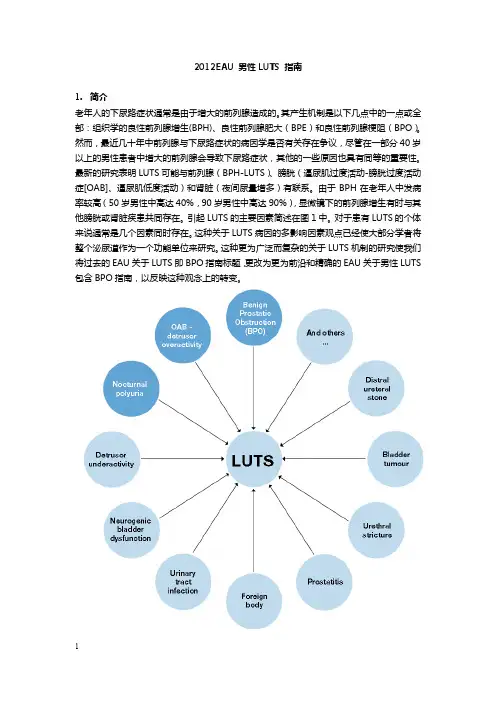
2012EAU 男性LUTS 指南1.简介老年人的下尿路症状通常是由于增大的前列腺造成的。
其产生机制是以下几点中的一点或全部:组织学的良性前列腺增生(BPH)、良性前列腺肥大(BPE)和良性前列腺梗阻(BPO)。
然而,最近几十年中前列腺与下尿路症状的病因学是否有关存在争议,尽管在一部分40岁以上的男性患者中增大的前列腺会导致下尿路症状,其他的一些原因也具有同等的重要性。
最新的研究表明LUTS可能与前列腺(BPH-LUTS)、膀胱(逼尿肌过度活动-膀胱过度活动症[OAB]、逼尿肌低度活动)和肾脏(夜间尿量增多)有联系。
由于BPH在老年人中发病率较高(50岁男性中高达40%,90岁男性中高达90%),显微镜下的前列腺增生有时与其他膀胱或肾脏疾患共同存在。
引起LUTS的主要因素简述在图1中。
对于患有LUTS的个体来说通常是几个因素同时存在。
这种关于LUTS病因的多影响因素观点已经使大部分学者将整个泌尿道作为一个功能单位来研究。
这种更为广泛而复杂的关于LUTS机制的研究使我们将过去的EAU关于LUTS即BPO指南标题,更改为更为前沿和精确的EAU关于男性LUTS 包含BPO指南,以反映这种观念上的转变。
由于病人因LUTS而来访并非是由于潜在的前列腺疾病,比如BPH或BPE,这次更新的指南来源于病人主诉各种各样的膀胱储尿期、排尿期和或排尿后后症状。
指南中更改的建议是基于最佳的可得证据。
这些更改建议适用于年龄40岁或以上的因各种非神经源性的良性LUTS疾患而来专科就诊的男性患者,比如LUTS/BPO、逼尿肌过度活动-OAB、夜尿症。
关于神经源性的LUTS的诊断与治疗在其他地方论述,适用于由于神经源性疾病而导致膀胱症状的男性或女性患者。
EAU指南关于尿失禁、泌尿系感染、泌尿系结石或恶性病变导致的LUTS在其他地方论述。
指南的修订意见是基于1966年到2010年1月发表在PubMed/Medline、Web of Science和Cochrane数据库的英文文献的系统性文献检索。
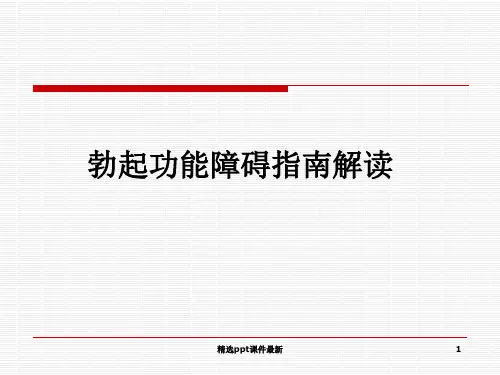
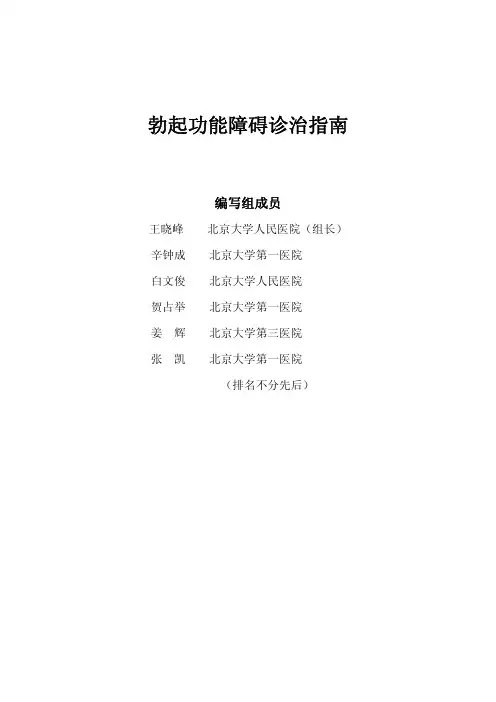


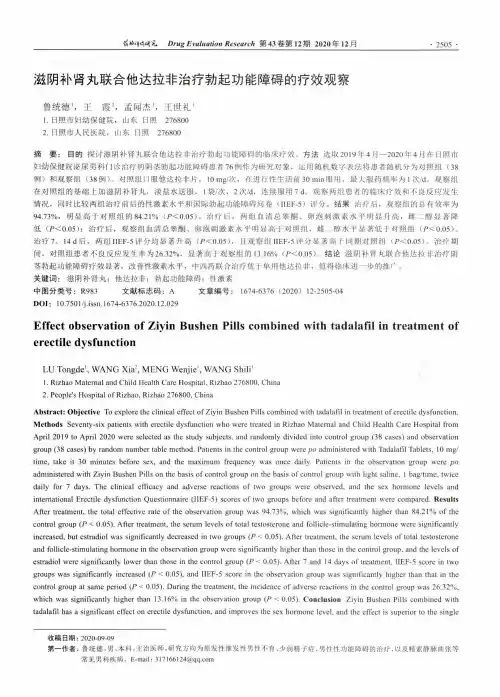
器持诗q吋元Drug Evaluation Research第43卷第12期2020年12月・2505・滋阴补肾丸联合他达拉非治疗勃起功能障碍的疗效观察鲁统德',王霞2,孟闻杰',王世礼'1.日照市妇幼保健院,山东日照2768002.日照市人民医院,山东日照276800摘要:目的探讨滋阴补肾丸联合他达拉非治疗勃起功能障碍的临床疗效。
方法选取2019年4月-2020年4月在日照市妇幼保健院泌尿男科门诊治疗的阴茎勃起功能障碍患者76例作为研究对象,运用随机数字表法将患者随机分为对照组(38例)和观察组(38例)。
对照组口服他达拉非片,10mg/次,在进行性生活前30min服用,最大服药频率为1次/d。
观察组在对照组的基础上加滋阴补肾丸,淡盐水送服,1袋/次,2次/d,连续服用7d。
观察两组患者的临床疗效和不良反应发生情况,同时比较两组治疗前后的性激素水平和国际勃起功能障碍问卷(IIEF-5)评分。
结果治疗后,观察组的总有效率为94.73%,明显高于对照组的84.21%(PV0.05)。
治疗后,两组血清总睾酮、卵泡刺激素水平明显升高,雌二醇显著降低(PV0.05);治疗后,观察组血清总睾酮、卵泡刺激素水平明显高于对照组,雌二醇水平显著低于对照组(PV0.05)。
治疗7、14d后,两组IIEF-5评分均显著升高(PV0.05),且观察组IIEF-5评分显著高于同期对照组(PV0.05)。
治疗期间,对照组患者不良反应发生率为26.32%,显著高于观察组的13.16%(PV0.05)。
结论滋阴补肾丸联合他达拉非治疗阴茎勃起功能障碍疗效显著,改善性激素水平,中西药联合治疗优于单用他达拉非,值得临床进一步的推广。
关键词:滋阴补肾丸;他达拉非;勃起功能障碍;性激素中图分类号:R983文献标志码:A文章编号:1674-6376(2020)12-2505-04DOI:10.7501/j.issn」674-6376.2020.12.029Effect observation of Ziyin Bushen Pills combined with tadalafil in treatment of erectile dysfunctionLU Tongde1,WANG Xia2,MENG Wenjie',WANG Shili'1.Rizhao Maternal and Child Health Care Hospital,Rizhao276800,China2.People's Hospital of Rizhao,Rizhao276800,ChinaAbstract:Objective To explore the clinical effect of Ziyin Bushen Pills combined with tadalafil in treatment of erectile dysfunction. Methods Seventy-six patients with erectile dysfunction who were treated in Rizhao Maternal and Child Health Care Hospital from April2019to April2020were selected as the study subjects,and randomly divided into control group(38cases)and observation group(38cases)by random number table method.Patients in the control group were po administered with Tadalafil Tablets,10mg/ time,take it30minutes before sex,and the maximum frequency was once daily.Patients in the observation group were po administered with Ziyin Bushen Pills on the basis of control group on the basis of control group with light saline,1bag/time,twice daily for7days.The clinical efficacy and adverse reactions of two groups were observed,and the sex hormone levels and international Erectile dysfunction Questionnaire(IIEF-5)scores of two groups before and after treatment were compared.Results After treatment,the total effective rate of the observation group was94.73%,which was significantly higher than84.21%of the control group(P<0.05).After treatment,the serum levels of total testosterone and follicle-stimulating honnone were significantly increased,but estradiol was significantly decreased in two groups(P<0.05).After treatment,the serum levels of total testosterone and follicle-stimulating hormone in the observation group were significantly higher than those in the control group,and the levels of estradiol were significantly lower than those in the control group(P<0.05).After7and14days of treatment,IIEF-5score in two groups was significantly increased(P<0.05),and IIEF-5score in the observation group was significantly higher than that in the control group at same period(P<0.05).During the treatment,the incidence of adverse reactions in the control group was26.32%, which was significantly higher than13.16%in the observation group(P<0.05).Conclusion Ziyin Bushen Pills combined with tadalafil has a significant effect on erectile dysfunction,and improves the sex honnone level,and the effect is superior to the single收稿日期:2020-09-09第一作者:鲁统德,男,本科,主治医师,研究方向为原发性继发性男性不育、少弱精子症,男性性功能障碍的治疗,以及精索静脉曲张等常见男科疾病。
Guidelines –Sexual MedicineGuidelines on Male Sexual Dysfunction:Erectile Dysfunction and Premature EjaculationKonstantinos Hatzimouratidis a ,*,Edouard Amar b ,Ian Eardley c ,Francois Giuliano d ,Dimitrios Hatzichristou a ,Francesco Montorsi e ,Yoram Vardi f ,Eric Wespes ga 2nd Department of Urology,Aristotle University of Thessaloniki,Thessaloniki,Greeceb Hoˆpital Bichat,Paris,France c Pyrah Department of Urology,St.James University Hospital,Leeds,UKd AP-HP,Neuro-Urology-Andrology,Raymond Poincare´Hospital,Garches,France e Department of Urology,University Vita-Salute San Raffaele,Scientific Institute H.San Raffaele,Milan,Italy f Department of Neuro-Urology,Rambam Medical Centre and Technion Faculty of Medicine,Haifa,Israel gHoˆpital Civil de Charleroi,Ho ˆpital Erasme,Urology Department,Brussels,Belgium E U R O P E A N U R O L O G Y X X X (2010)X X X –X X Xa v a i l ab l e a t w w w.sc i e n c ed i re c t.c o mj o u r n a l h o m e p a g e :w w w.e u r o p e a n u r o l o g y.c omArticle infoArticle history:Accepted February 10,2010Published online ahead of print on February 20,2010Keywords:Erectile dysfunctionMale sexual dysfunction Premature ejaculation EAU GuidelinesAbstractContext:Erectile dysfunction (ED)and premature ejaculation (PE)are the two most prevalent male sexual dysfunctions.Objective:To present the updated version of 2009European Association of Urology (EAU)guidelines on ED and PE.Evidence acquisition:A systematic review of the recent literature on the epidemiology,diagnosis,and treatment of ED and PE was performed.Levels of evidence and grades of recommendation were assigned.Evidence synthesis:ED is highly prevalent,and 5–20%of men have moderate to severe ED.ED shares common risk factors with cardiovascular disease.Diagnosis is based on medical and sexual history,including validated questionnaires.Physical examination and laboratory testing must be tailored to the patient’s complaints and risk factors.Treatment is based on phosphodiesterase type 5inhibitors (PDE5-Is),including sildenafil,tadalafil,and vardenafil.PDE5-Is have high efficacy and safety rates,even in difficult-to-treat populations such as patients with diabetes mellitus.Treatment options for patients who do not respond to PDE5-Is or for whom PDE5-Is are contraindicated include intracav-ernous injections,intraurethral alprostadil,vacuum constriction devices,or implantation of a penile prosthesis.PE has prevalence rates of 20–30%.PE may be classified as lifelong (primary)or acquired (secondary).Diagnosis is based on medical and sexual history assessing intravaginal ejaculatory latency time,perceived control,distress,and interpersonal difficulty related to the ejaculatory dysfunction.Physical examination and laboratory testing may be needed in selected patients only.Pharmacotherapy is the basis of treatment in lifelong PE,including daily dosing of selective serotonin reuptake inhibitors and topical anaesthetics.Dapoxetine is the only drug approved for the on-demand treatment of PE in Europe.Behavioural techniques may be efficacious as a monotherapy or in combination with pharmacotherapy.Recurrence is likely to occur after treatment withdrawal.Conclusions:These EAU guidelines summarise the present information on ED and PE.The extended version of the guidelines is available at the EAU Web site (/nc/professional-resources/guidelines/online/).#2010European Association of Urology.Published by Elsevier B.V.All rights reserved.*Corresponding author.2nd Department of Urology,Aristotle University of Thessaloniki,54006,Thessaloniki,Greece.Tel.+302310991543;Fax:+302310676092.E-mail address:kchatzim@med.auth.gr (K.Hatzimouratidis).0302-2838/$–see back matter #2010European Association of Urology.Published by Elsevier B.V.All rights reserved.doi:10.1016/j.eururo.2010.02.0201.IntroductionErectile dysfunction (ED;or impotence)and premature ejaculation (PE)are the two most prevalent complaints in male sexual medicine.The most recent summary of the European Association of Urology (EAU)guidelines on ED was published in 2006.The EAU’s Guidelines Office decided to expand these guidelines to include PE.Therefore,the new guidelines include an update of the ED guidelines and a completely new section on PE based on a review of available scientific information,current research,and clinical prac-tice in the field.(The extended version of the guidelines is available at the EAU Web site [/nc/professional-resources/guidelines/online/].)Levels of evi-dence and grades of recommendation also were assigned.The aim of this review is to present a summary of the 2009update of the EAU guidelines on ED and PE.2.Erectile dysfunction2.1.Definition,epidemiology,and risk factorsED is the persistent inability to attain and maintain an erection sufficient to permit satisfactory sexual perfor-mance [1].ED affects physical and psychosocial health and has a significant impact on the quality of life (QoL)of sufferers and their partners and families.Epidemiologic studies of ED suggest that approximately 5–20%of men have moderate to severe ED [2].The difference in reported incidences is probably due to differences in the methodol-ogy and in the age and socioeconomic status of the study populations.ED shares common risk factors with cardiovascular disease,including lack of exercise,obesity,smoking,hypercholesterolaemia,and metabolic syndrome [3].The risk of ED may be reduced by modifying these risk factors,particularly exercising or losing weight [4].Another risk factor for ED is radical prostatectomy (RP)in any form (open,laparoscopic,or robotic)because of the risk of cavernosal nerve injury,poor oxygenation of the corpora cavernosa,and vascular insufficiency.Some 25–75%of men undergoing RP experience postoperative ED.Patients being considered for nerve-sparing RP,ideally,should be potent,and the cavernosal nerves must be preserved to ensure erectile function recovery after RP [5].2.2.Diagnosis and work-up 2.2.1.Basic work-upThe basic work-up (minimal diagnostic evaluation)out-lined in Fig.1must be performed in every patient with ED [6].Because of the potential cardiac risks associated with sexual activity,the Second Princeton Consensus Conference [7]stratified patients with ED wanting to initiate or resume sexual activity into three risk categories.The low-risk group included asymptomatic patients with fewer than three risk factors for coronary artery disease (excluding male gender),mild or stable angina (evaluated and/or being treated),uncomplicated past myocardial infarction,left ventriculardysfunction or congestive heart failure (New York Heart Association class I),postsuccessful coronary revascularisa-tion,controlled hypertension,and mild valvular disease.All other patients were included in intermediate-or high-risk categories and required a cardiology consultation prior to engaging in sexual activity (sexual activity for high-risk patients is not recommended).2.2.2.Specific examinations and testsAlthough most patients with ED can be managed within the primary care setting,some circumstances,presented in Table 1,require specific diagnostic testing [1].Specific diagnostic tests are presented in Table 2.Nocturnal penile tumescence and rigidity testing using Rigiscan should take place for at least two nights.A functional erectile mechanism is indicated by an erectile event of 60%rigidity recorded on the tip of the penis lasting for 10min [8].The intracavernous injection test provides limited information about vascular status;however,duplex ultra-sound provides a simple (albeit intrusive)way of assessing vascular status.Further vascular investigation is unneces-sary if duplex ultrasound is normal,as indicated by a peak systolic blood flow >30cm/s and a resistance index >0.8.If the ultrasound is abnormal,however,arteriography and dynamic infusion cavernosometry and cavernosography should be performed only in patients who are potential candidates for vascular reconstructive surgery [9].A summary of recommendations for the diagnostic work-up of ED is presented in Table 3.2.3.Treatment of erectile dysfunctionOnly certain types of ED have the potential to be cured with specific treatments.For psychogenic ED,psychosexual therapy may be given either alone or with anotherTable 1–Indications for specific diagnostic testsPatients with primary erectile disorder (not caused by organic disease or psychogenic disorder)Young patients with a history of pelvic or perineal trauma who could benefit from potentially curative vascular surgeryPatients with penile deformities (eg,Peyronie’s disease,congenital curvature)that might require surgical correctionPatients with complex psychiatric or psychosexual disorders Patients with complex endocrine disordersSpecific tests may also be indicated at the request of the patient or his partnerFor medicolegal reasons (eg,penile prosthesis implant,sexual abuse)Table 2–Specific diagnostic testsNocturnal penile tumescence and rigidity using Rigiscan Vascular studiesIntracavernous vasoactive drug injection Duplex ultrasound of the cavernous arteriesDynamic infusion cavernosometry and cavernosography Internal pudendal arteriographyNeurologic studies (eg,bulbocavernosus reflex latency,nerve-conduction studies)Endocrinologic studiesSpecialised psychodiagnostic evaluationE U R O P E A N U R O L O G Y X X X (2010)X X X –X X X2therapeutic approach,but this therapy takes time and has had variable results [10].For posttraumatic arteriogenic ED in young patients,surgical penile revascularisation has a 60–70%long-term success rate [11].For hormonal causes of ED,testosterone replacement therapy is effective but should be used only after other endocrinologic causes for testicular failure have been excluded.Although some data suggest that testosterone administration does not cause prostate cancer,it is currently contraindicated in men with a history of prostate carcinoma or with symptoms of prostatism.Close follow-up is neces-sary,including digital rectal examination,serum prostate-specific antigen testing,and haematocrit assessmentasFig.1–Basic diagnostic work-up in patients with erectile dysfunction.ED =erectile dysfunction;IIEF =International Index of Erectile Function.Table 3–Recommendations for the diagnostic work-up of erectile dysfunction (ED)RecommendationsLEGRClinical use of a validated questionnaire related to ED may help assess all sexual function domains and the effect of a specific treatment modality.3B Physical examination is needed in the initial assessment of ED to identify underlying medical conditions associated with ED.4B Routine laboratory tests,including glucose-lipid profile and total testosterone,are required to identify and treat any reversible risk factors and modifiable lifestyle factors.4B Specific diagnostic tests are indicated by only a few conditions.4BLE =level of evidence;GR =grade of recommendation.E U R O P E A N U R O L O G Y X X X (2010)X X X –X X X3well as monitoring of the development of hepatic or prostatic disease [12].Although there is some debate,the use of pro-erectile drugs following RP seems important in achieving erectile function following surgery.Several trials have shown higher rates of recovery of post-RP erectile function in patients receiving any phosphodiesterase type 5inhibitor (PDE5-I)or intracavernosal injections (therapeutic or prophylactic).Rehabilitation should start as soon as possible following RP [5].Most men with ED will be treated with options that are not cause specific [1].This approach requires a structured treatment strategy that depends on efficacy,safety,invasiveness,and cost as well as patient and partner satisfaction.The choice of treatment options must consider the effects on patient and partner satisfaction and other QoL factors as well as efficacy and safety.A treatment algorithm for ED is given in Fig.2.A summary of recommendations for the treatment of ED is presented in Table 4.Fig.2–Treatment algorithm for erectile dysfunction (ED).PDE5=phosphodiesterase type 5.E U R O P E A N U R O L O G Y X X X (2010)X X X –X X X42.3.1.First-line therapy2.3.1.1.Oral pharmacotherapy.Three potent selective PDE5-Ishave been approved by the European Medicines Agency for the treatment of ED [13].They are not initiators of erection and require sexual stimulation for an erection to occur.Efficacy is defined as rigidity sufficient for vaginal penetration.Sildenafil (Viagra),launched in 1998,was the first PDE5-I available.It is effective 30–60min from administration.A heavy fatty meal may reduce or prolong absorption.It is administered in 25-,50-,and 100-mg doses.The recom-mended starting dose is 50mg,which is adapted according to patient response and side-effects.Efficacy may last for up to 12h.In premarketing studies,after 24wk of treatment in a dose-response study,improved erections were reported by 56%,77%,and 84%of men taking 25,50,and 100mg of sildenafil,respectively,compared with 25%of men taking placebo.The efficacy of sildenafil in almost every subgroup of patients with ED has been well established in pre-and postmarketing studies.Tadalafil (Cialis)was licensed for ED in 2003.It is effective from 30min after administration,but its peak efficacy occurs after about 2h.Efficacy is maintained for up to 36h.Its efficacy is not affected by food.It is administered in 10-and 20-mg doses.The recommended starting dose is 10mg,which is adapted according to patient response and side-effects.In premarketing dose-response studies,im-proved erections were reported after 12wk of treatment by 67%and 81%of men taking 10mg and 20mg of tadalafil,respectively,compared with 35%of men taking placebo.The results were confirmed in postmarketing studies.Tadalafil also improved erections in difficult-to-treat subgroups.Vardenafil (Levitra)was licensed for ED in 2003.It is effective 30min from administration.A fatty meal (>57%in fat)reduces its effect.It is administered in 5-,10-,and 20-mg doses.The recommended starting dose is 10mg,which is adapted according to the response and side-effects.In vitro,it is 10-fold more potent than sildenafil;however,this does not necessarily mean greater clinical efficacy.In premarketing dose-response studies,improved erections after 12wk of treatment were reported by 66%,76%,and 80%of men taking 5mg,10mg,and 20mg of vardenafil,respectively,compared with 30%of men taking placebo.Efficacy was confirmed in postmarketing studies.Vardenafil also improved erections in difficult-to-treat subgroups.2.3.1.1.1.Choice of or preference for different phosphodiesterase type 5inhibitors.The choice of a PDE5-I depends on thefrequency of intercourse (occasional use or regular therapy,three to four times weekly)and the patient’s personal experience with the agent.Consideration should be given to which drug better fits the patient’s premorbid sexual script with his partner to optimise response.Patients need to know whether a drug is short or long acting,its possible disadvantages,and how to use it.2.3.1.1.2.On-demand or chronic use of phosphodiesterase type 5inhibitors.Although PDE5-Is were initially introduced as on-demand treatment,in 2008,tadalafil was also approved for continuous,everyday use in 2.5-and 5-mg doses.Two studies [14,15]assessing daily use of 5-and 10-mg tadalafil for 12wk and daily use of 2.5-and 5-mg tadalafil for 24wk showed that daily dosing was well tolerated and signifi-cantly improved erectile function.Similar results have been found in diabetic patients [16].These studies,however,lacked an on-demand treatment arm.Daily tadalafil provides an alternative to on-demand dosing for couples who prefer spontaneous rather than scheduled sexual activity or who have frequent sexual activity.Daily dosing overcomes the requirement for dosing and sexual activity to be temporally linked.Other studies have shown that chronic but not on-demand tadalafil treatment improved endothelial function,with sustained effects after its discontinuation.This finding was confirmed in another study of chronic sildenafil use in men with type 2diabetes [17].In contrast,a randomised clinical study found that once-daily dosing of vardenafil at 10mg/d did not offer any sustainable effect after cessation of treatment compared with on-demand vardenafil in patients with mild to moderate ED [18].2.3.1.1.3.Adverse mon adverse events includeheadache (10–16%),flushing (5–12%),dyspepsia (4–12%),nasal congestion (1–10%),and dizziness (2–3%)[13].Sildenafil and vardenafil have been associated with visual abnormalities in <2%of patients,while tadalafil has beenTable 4–Recommendations for the treatment of erectile dysfunction (ED)RecommendationsLEGRLifestyle changes and risk factor modification must precede or accompany ED treatment.1b A Pro-erectile treatments must be given at the earliest opportunity after radical prostatectomy.1b A If a curable cause of ED is found,treat the cause first.1b B PDE5-Is are first-line therapy.1a A Daily administration of PDE5-Is may improve results and restore erectile function.1b A Inadequate/incorrect prescription and poor patient education are the main causes of a lack of response to PDE5-Is.3B Testosterone replacement restores efficacy in hypogonadic nonresponders to PDE5-Is.1b B Apomorphine can be used in mild to moderate ED,psychogenic ED,or in patients with contraindications to PDE5-Is.1b B A vacuum constriction device can be used in patients with stable relationship.4C Intracavernous injection is second-line therapy.1b B Penile implant is third-line therapy.4CLE =level of evidence;GR =grade of recommendation;PDE5-I =phosphodiesterase type 5inhibitor.E U R O P E A N U R O L O G Y X X X (2010)X X X –X X X5associated with back pain/myalgia in 6%of patients.Adverse events are generally mild in nature and self-limited by continuous use,and the dropout rate due to adverse events is similar to that seen with placebo.2.3.1.1.4.Cardiovascular safety.Clinical trials and postmar-keting data of all PDE5-Is have demonstrated no increase in myocardial infarction rates [17].No PDE5-I has adversely affected total exercise time or time to ischemia during exercise testing in men with stable angina.In fact,they may improve exercise tests.Nitrates are totally contraindicated with all PDE5-Is due to unpredictable hypotension.The duration of interaction between organic nitrates and PDE5-Is varies according to the PDE5-I and nitrate.If a patient develops angina while using a PDE5-I,other antiangina agents may be used instead of nitroglycerine or until the appropriate time has passed (24h for sildenafil or vardenafil and 48h for tadalafil)[17].In general,the adverse event profile of the PDE5-I is not worsened,even when the patient is on multiple antihyper-tensive agents.2.3.1.1.5.a -Blocker interactions.The concomitant use ofPDE5-Is with a -blockers may result in orthostatic hypoten-sion under some conditions.The labelling for sildenafil currently includes a precaution advising that 50or 100mg (not 25mg)of sildenafil should not be taken within 4h of taking an a -blocker.The use of vardenafil with an a -blocker is not recommended;however,coadministration of vardenafil with tamsulosin is not associated with clinically significant hypotension.Tadalafil is contraindicated in patients taking a -blockers,except for tamsulosin [17].Generally,the patient should be stable in his a -blocker therapy before using a PDE5-I.The long-acting a -blockers (doxazosin,terazosin)should be avoided in this concomitant use.Alfuzosin and tamsulosin are the preferred a -blockers.2.3.1.1.6.Dosage adjustments.Lower doses of PDE5-Is maybe required in patients taking ketoconazole,itraconazole,erythromycin,clarithromycin,and HIV protease inhibitors (ritonavir,saquinavir)[13].Higher doses of PDE5-Is may be necessary in patients taking rifampicin,phenobarbital,phenytoin,or carbamazepine.Kidney or hepatic dysfunction may require dose adjustments.In patients with hypogonad-ism,androgen supplementation improves erectile response.2.3.1.1.7.Management of nonresponders to phosphodiesterase type 5inhibitors.The two main reasons that patients fail torespond to a PDE5-I are either incorrect drug use or inefficacy of the drug [13].Physicians should check that the patient is using a licensed medication and that the medication has been properly prescribed and correctly used (ie,that there is adequate sexual stimulation and dosage and enough time between taking the medication and an attempt at intercourse).Provided that a patient is using a PDE5-I appropriately,efficacy can be improved in several ways,including modification of associated risk factors,treatment ofassociated hypogonadism,changing to another PDE5-I,or continuous use of a PDE5-I.Limited evidence supports using these interventions [19].Additionally,an accumulating body of evidence supports the use of psychosexual educational counselling in combination with pharmaceuti-cal treatments to further optimise response.2.3.1.2.Vacuum constriction devices.A vacuum constrictiondevice (VCD)applies negative pressure to the penis to draw venous blood into the penis,which is then retained by application of a visible constricting band at the base of the penis.This method seems more acceptable to older patients [20].Efficacy,defined by an erection satisfactory for intercourse,is as high as 90%.Satisfaction rates range between 27%and 94%[20].After 2yr,only 50–64%of men continue to use VCDs.Most men who discontinue use of VCDs do so within 3mo.The adverse effects associated with vacuum therapy are penile pain,numbness,and delayed ejaculation;these effects occur in <30%of patients.2.3.2.Second-line therapyPatients not responding to oral drugs may be offered intracavernous injections.Alprostadil (Caverject,Edex/Viridal)is the only drug approved for intracavernous treatment of ED.It is the most efficacious monotherapy for intracavernous treatment using 5-to 40-m g doses [21].Erection appears after 5–15min and lasts according to the dose injected.The patient should be enrolled in an office-based training programme (one or two visits)to learn the correct injection process.Efficacy rates are about 70%,with reported sexual activity after 94%of injections and satisfaction rates of 87–93.5%in patients and 86–90.3%in partners.Dropout rates of 41–68%have been reported,with most dropouts occurring within the first 2–3mo [22].Complications of intracavernous alprostadil include penile pain (50%of patients after 11%of injections),prolonged erections (5%),priapism (1%),and fibrosis (2%)[13].Drug combinations (mainly the three-drug combina-tion of alprostadil plus papaverine plus phentolamine)may increase efficacy by up to 90%.Fibrosis was found to be more common (5–10%)if papaverine was used (depending on total dose).After 4h of erection,patients are advised to consult their doctors to avoid any damage to the intracavernous tissue,as this will result in permanent impotence [21].A 19-gauge needle is used to aspirate blood and decrease the intracavernous pressure.This simple technique is usually sufficient to make the penis flaccid.If the penis then becomes rigid again,phenylephrine should be injected into the intracavernous muscle,starting at 200m g every 5min and increasing to 500m g if necessary.If this problem occurs,the dosage of the next intracavernosal injection is usually reduced.Prostaglandin E1may be administered intraurethrally as a semisolid pellet (125–1000m g)[23].A band placed at the base of the penis improves the resulting rigidity.The clinical success rate is lower than with intracaver-nosal injections,but about 70%of patients are satisfied or very satisfied with treatment.Side-effects include localE U R O P E A N U R O L O G Y X X X (2010)X X X –X X X6pain (29–41%),dizziness (1.9–14%),and urethral bleeding (5%).2.3.3.Third-line therapy (penile prostheses)Surgical implantation of a penile prosthesis may be considered in patients who fail pharmacotherapy or who want a permanent solution.Prostheses are either malleable (semirigid)or inflatable (two or three piece).Most patients prefer the three-piece inflatable devices because erections are more ‘‘natural,’’but these implants are much more expensive.Satisfaction rates of 70–87%are reported from patients after appropriate consultation [24].The two main complications of penile prosthesis implantation are mechanical failure (<5%after 5-yr follow-up with currently available three-piece prostheses)and infection [25].With antibiotic prophylaxis,the infection rate is 2–3%and may be further reduced by using an antibiotic-impregnated or hydrophilic-coated implant.Infection requires removing the prosthesis,antibiotic administration,and reimplantation after 6–12mo;however,an 82%success rate has been achieved using salvage therapy,involving removal and reimplantation immediately following copious irrigation of the corpora with a multiantibiotic solution [24].Although diabetes is considered to be a main risk factor for infection,this association is not supported by current data.3.Premature ejaculation3.1.Definition,epidemiology,and risk factorsThere has been difficulty in gaining consensus about how best to define PE.The Second International Consultation on Sexual and Erectile Dysfunction has defined PE as ‘‘ejacula-tion with minimal stimulation and earlier than desired,before or soon after penetration,which causes bother or distress,and over which the sufferer has little or no voluntary control’’[26].The International Society for Sexual Medicine has adopted a completely new definition,and the first evidence-based definition,for lifelong PE:‘‘Premature ejaculation is a male sexual dysfunction characterised by ejaculation which always or nearly always occurs prior to or within about one minute of vaginal penetration;and inability to delay ejaculation on all or nearly all vaginal penetrations;and negative personal consequences,such as distress,bother,frustration and/or the avoidance of sexual intimacy’’[27].All definitions have taken into account the time to ejaculation,the inability to control or delay ejaculation,and the negative consequences (bother/distress)from PE.PE may be classified as lifelong (primary)or acquired (secondary)[28].Lifelong PE is characterised by onset from the first sexual experience and remains a problem through-out life.Ejaculation occurs too quickly,either before vaginal penetration or <1–2min afterwards.Acquired PE is char-acterised by a gradual or sudden onset,with ejaculation being normal before onset of the problem.Time to ejaculation is short but not usually as fast as in lifelong PE [27].PE is a common male sexual dysfunction,with preva-lence rates of 20–30%[29,30].Limited data suggest that the prevalence of lifelong PE,defined as intravaginal ejaculatorylatency time (IELT)<1–2min,is about 2–5%[31].The aetiology of PE is unknown,with little data to support suggested biological and psychological hypotheses,includ-ing anxiety,penile hypersensitivity,and serotonin receptor dysfunction [26].In contrast to ED,the prevalence of PE is not affected by age [29,30].Risk factors for PE are generally unknown.PE has a detrimental effect on self-confidence and on relationship with the partner.It may cause mental distress,anxiety,embarrassment,and depression;however,most men with PE do not seek help [30].3.2.Diagnostic work-upDiagnosis of PE is based on the patient’s medical and sexual history [32].The history should classify PE as lifelong or acquired and determine whether PE is situational (under specific circumstances or with a specific partner)or consistent.Special attention should be given to the length of time of ejaculation,degree of sexual stimulus,impact on sexual activity and QoL,and drug use or abuse.It is also important to distinguish PE from ED.The use of IELT alone is not sufficient to define PE because there is significant overlap between men with and without PE [33].In everyday clinical practice,self-estimated IELT is sufficient.Diagnosis should be multidimensional and should assess IELT,perceived control,distress,and inter-personal difficulty due to ejaculatory dysfunction.The need to assess PE objectively has produced several question-naires,such as the Premature Ejaculation Diagnostic Tool (PEDT)[34].Other questionnaires used to characterise PE and determine treatment effects include the Premature Ejaculation Profile (PEP)[31],the Index of Premature Ejaculation (IPE)[35],and the Male Sexual Health Questionnaire Ejaculatory Dysfunction (MSHQ-EjD)[36].Currently,their role is optional in everyday clinical practice.Physical examination includes a brief examination of the vascular,endocrine,and neurologic systems to identify underlying medical conditions associated with PE or other sexual dysfunctions,such as chronic illness,endocri-nopathy,autonomic neuropathy,Peyronie’s disease,ure-thritis,or boratory or physiologic testing should be directed by specific findings from history or physical examination and is not routinely recommended [32].A summary of recommendations for the diagnosis of PE is presented in Table 5.3.3.Treatment of premature ejaculationIn many relationships,PE causes few if any problems [28].In such cases,treatment should be limited to psychosexual counselling.Before beginning treatment,it is essential to discuss patient expectations thoroughly.ED or other sexual dysfunction or genitourinary infection (eg,prostatitis)should be treated first or at the same time as PE.Various behavioural techniques have demonstrated benefit in treating PE.In lifelong PE,behavioural techniques are not recommended for first-line treatment [27].They are time intensive,require the support of a partner,and can be difficult to do.E U R O P E A N U R O L O G Y X X X (2010)X X X –X X X7。